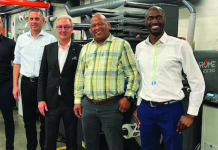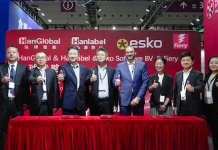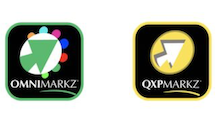The Gallus Labelfire has successfully passed its field test, as reported by Birkhäuser + GBC AG, a subsidiary of SCHELLING AG, only a short time after the press was installed with low migration equipment.
In the Reinach plant near Basel, the company has been able to print a variety of labels and flexible packaging in accordance with low migration requirements since July 2020. The native print resolution of 1200 dpi and the flexibility of the hybrid label printing press are outstanding. It is already the second Gallus Labelfire for Birkhäuser.
Marcel Häsler, COO at Birkhäuser, is impressed, ’The new Gallus Labelfire 340 with low migration equipment is the perfect machine for us. This digital printing press is the ideal addition not only to the flexo printing presses in this segment but also to our first Labelfire. Now we can offer the whole range of applications for the food sector, which meet all relevant low migration requirements – from flexible packaging and labels, paper bags and folding cartons to self-adhesive labels with cold foil finishing or lacquer effects.’
The second hybrid press from Gallus is an important addition to the machinery in the area of labels and flexible packaging. The heart of the Gallus Labelfire is the Digital Print Unit (DPU) with seven colours. Before and after the inkjet printing unit, flexo printing units provide more flexibility and cost efficiency in label and packaging printing. This is achieved through the implementation of inline production. For example, cost-effective varnish application, high-quality cold foil embossing or customer-specific printing of spot colours or white can be integrated.
The subsidiary of SCHELLING AG once again underlines its technological leadership with the Gallus Labelfire installed in July 2020. With a successful field test, this press is the second of its kind in the subsidiary in Reinach, Switzerland. Four years ago, Birkhäuser was one of the first printers on the market to invest in a Gallus Labelfire 340. Quite a few improvements have been made since then, not only in terms of low migration compatibility, but also in terms of speed, ‘white line compensation’ and Prinect workflow integration.
Due to the short set-up times, the machine system offers a high flexibility. As a result, short runs, i.e. jobs with short run lengths, are part of the daily business, because of the high cost-efficiency. Tobias Grolimund, Head of Production, confirmed, ‘The set-up times for a digital printing press are very short compared to conventional printing processes such as offset or flexo.’
The high print quality was a further reason for the investment: due to the inkjet printing unit with seven colours and 1200 dpi resolution, up to 96% of the Pantone Plus colour space is covered. Due to the high reproducibility, even complex print jobs can be fully reproduced with the Gallus Labelfire within a short time – at the push of a button.
Another influencing factor for SCHELLING AG in investing in the low-migration edition of the Gallus Labelfire was the positive experience with the first Labelfire, ‘The system is just great and runs extremely stable,’ explained Häsler. ‘It is still the only digital printing press that can reproduce 1-point fonts, thus it can print such small font sizes.’ According to SCHELLING AG, fonts in this size are common standard requirements for pharmaceutical customers and are needed e.g. for product traceability. ‘I don’t know any other machine that is able to do this. This is beyond comparison.’
Grolimund, who has significantly pushed forward digital label printing at Birkhäuser, said, ‘The Labelfire is a reliable and stable machine. This differentiates this digital press from conventional printing machines.’
Birkhäuser’s printing experts had reviewed different systems. A toner-based printing process has certain advantages regarding the low-migration ink system, but UV inkjet convinces with its speed and print quality. Grolimund is impressed, ‘With the integration of the Labelfire with low migration equipment we have a great extension to the first digital printing press. Also the great ink adhesion was a pleasant surprise. The drying and anchoring of the ink with UV inkjet is very good, even with uncoated paper.’
The Gallus Labelfire includes a pinning after each print head row. This first drying step ensures that the inks do not run into each other – the foundation for very small fonts or fine lines. The Digital Print Unit (DPU) is followed by UV boosters from GEW to produce applications with low migration compliance even at high speeds. Migration tests were done on the Gallus Labelfire at Heidelberger Druckmaschinen in Wiesloch, Germany. The low migration compliance was confirmed by the Swiss laboratory service provider Swiss Quality Testing Services (SQTS).
The fact that no pre-priming is necessary as well as the procedure for substrate qualification are further advantages for Birkhäuser. The colours do not have to be calibrated every week, like with other digital printing machines. Replacing a printhead e.g. may require a new qualification. The qualification serves as the basis for the high level of reproducibility, as Grolimund confirmed, ‘Once qualified, the Labelfire constantly offers reliable reproducibility.’
‘The Labelfire Plus – as we call it internally – gives us the necessary flexibility for our customers and once again confirms our goal of technological leadership. We can offer our food customers low-migration-compliant and permanently reproducible applications with excellent print quality and very small font sizes as well as short order sizes,’ said Häsler.
‘We can now cover more applications and therefore more customer jobs, so I expect that the machine’s full capacity will soon be reached,’ added Grolimund.
[sc name=”whatsapp_subscribe” ]
HEIDELBERG
https://www.heidelberg.com/





















